DOS
Top 10 Best DOS Games of All Time!
DOS is a family of disk operating systems that dominated the x86-based IBM PC compatible market between 1981 and 1995. Although various versions of DOS were released, Microsoft’s MS-DOS (also branded as IBM PC DOS) was by far the most prevalent. A variety of home computers have been discussed on this site already, but DOS is a different animal altogether. Unlike the other gaming platforms we’ve covered, DOS is an operating system that could be used with a wide variety of hardware configurations. It’s easy to compare like-for-like when you’re counting down the best Atari 2600 titles, but a list of best DOS games will require you to compare apples to oranges. Games from the early ’80s that could potentially run on 186 machines are going to be compared with games from the mid ’90s that were created with Pentiums in mind. As a result, you’re likely to see a recency bias on this list. Many groundbreaking games – like King’s Quest, Dune II, and Wolfenstein 3D – failed to crack the top ten, so keep in mind that this is a list of best games rather than a list of most influential or revolutionary games.
10
Day of the Tentacle
1993
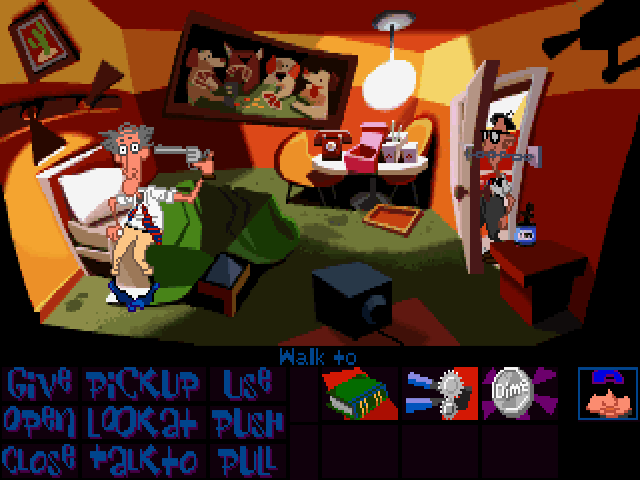
The 1990s saw the rise of first-person shooters and real-time strategy games, but there was a time when MS-DOS was largely defined by adventure games. Sierra On-line deserves credit for shaping the genre, but it’s up to LucasArts to represent the genre on this list. I’ve spoken at length about the Monkey Island games, and I’d love to give more attention to gems like Full Throttle. Looking back, however, Day of the Tentacle stands out as the most enjoyable adventure game of its day. The sequel to Maniac Mansion was defined by an intuitive point-and-click interface and a quirky sense of humor. It was also the first LucasArts adventure game to incorporate voice work, and the quality of the animation was akin to a Saturday morning cartoon. These factors accentuated the zany personalities and contributed to the game’s humor. The story was surprisingly complex, too. The game required you to swap between characters, and the plot relied heavily on time travel. Items left in the past could be re-used in the future, and your actions in one time period could alter the time stream. Puzzles somehow seem more meaningful when they can shape the course of history. Whether you were rewriting the US Constitution or visiting a future where humans were kept as pets, the game never stopped being entertaining.
9
Duke Nukem 3D
1996
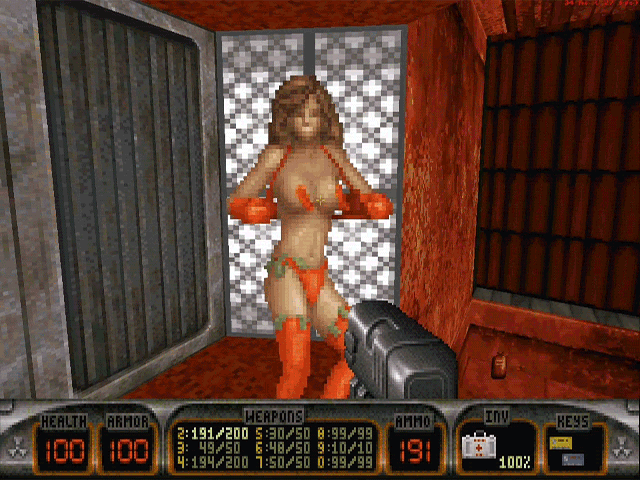
Duke Nukem burst onto computer screens in 1991, defending the world against killer robots and evil aliens in a simplistic side-scrolling platform game comparable to Commander Keen. He had more attitude in the 1993 sequel, but everything was turned up to 11 when he made the jump to 3D in 1996. Duke Nukem 3D is an over-the-top first-person shooter that takes a tongue-in-cheek approach to the genre. The game is laced with pop culture references, and Duke’s personality draws heavy influence from Hollywood action heroes. During the game, players will visit military bases, flooded cities, space stations, moon bases, strip joints, and a Japanese restaurant. The levels are cleverly designed, and they encourage players to use air ducts, back alleys, and sewer systems to stay alive. The levels are also highly interactive, and most props can be destroyed. Duke Nukem 3D was surrounded in controversy following its release, and it’s easy to see why. Women were painted as sex objects, cops were depicted as pigs, and Duke Nukem was toxic masculinity personified. Reasonable people understand the difference between reality and fiction, however, so most people simply viewed the game as a harmless form of escapism. If you look past the controversial elements, you’ll find a well-designed game that’s still a blast to play. Duke’s brazen nature is somehow even more refreshing today than it was in 1996.
8
Warcraft II: Tides of Darkness
1995
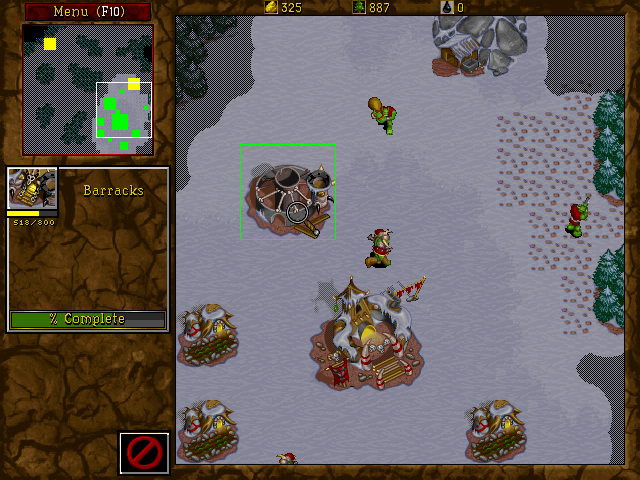
Warcraft: Orcs & Humans was one of the most influential real-time strategy games of the early 1990s. Most RTS games challenged players to gather resources, build armies, and crush their opposition. Warcraft expanded on this formula with missions that required players to rebuild besieged towns or rescue friendly forces from the enemy. The biggest contribution that Warcraft made to the genre was its large-scale multiplayer capabilities. The AI was somewhat predictable, so being able to play against a human opponent was a welcomed feature. It’s also the biggest reason why the RTS genre became so popular in the first place. Warcraft broke new ground, but the sequel improved upon the original in almost every way. New units opened the door to new strategies, the innovative “fog of war” mechanic added depth to the game’s scouting mechanics, and the ability to select multiple units and access command menus with a simple mouse click made the game feel more streamlined than its predecessor. The ability to play over the Internet was a novel concept in 1995, and the game felt like a window to the future in that regard. The single-player campaign was filled with memorable characters and missions, and the multiplayer component brought its own nuances and intricacies. It’s no wonder the game had so much staying power. On a related note, the game was overflowing with personality, and I was immediately taken in by its absurd sense of humor.
7
Star Wars: TIE Fighter
1994
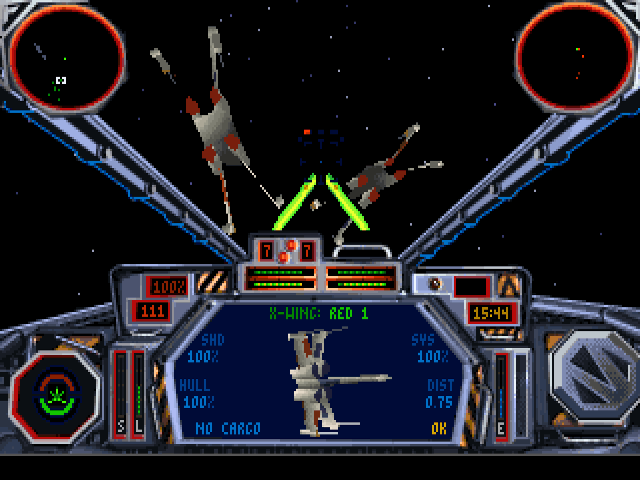
I cut my teeth on console games, but I’ll be the first to admit that some genres were almost always better on PC. We’ve already looked at an adventure game, a first-person shooter, and a real-time strategy game, so the time is nigh to turn our attention to the world of flight sims. Released in 1993, X-Wing let players assume the role of a Rebel pilot. As one of the first games to use 3D polygon graphics for spaceships, it captured the feel of the Star Wars universe and was heralded as the first authentic space-combat simulator. The action was anything but mindless, however, and players had to find the right balance between weapons, engines, and shields. A year later, TIE Fighter changed gears by showing things from the perspective of an Imperial star pilot. The story had a surprising amount of nuance this time around, and it was fascinating to see the war from the other side of the battle lines. The objectives varied from one mission to the next, and players had to engage in dogfights, escort other spacecrafts, inspect vehicles, and attack capital ships. You could also complete secondary objectives to gain favor with the Emperor. TIE Fighter improved upon its predecessor in a number of key areas. The shading was better, the AI was vastly improved, and the targeting system was more advanced. The ability to hone in on specific components (like shield generators and weapons) was an especially welcome addition. Countless flight sims were released on DOS, but none were more thrilling than TIE Fighter.
6
Civilization
1991
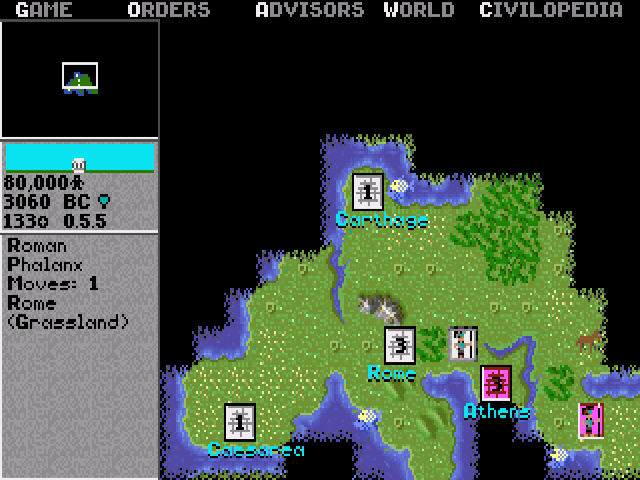
Sid Meier’s Civilization is a turn-based strategy game that challenges players to build and expand an empire through the ages. The player controls all aspects of their civilization – including exploration, culture, religion, military deployment, foreign policy, and trade. At the same time, your settlers will be able to alter terrain, establish mines, and build roads to connect cities together. The game begins before the Bronze Age and can extend all the way into the Space Age, and new technologies are developed over time. You’ll work with simple technologies like pottery near the beginning of the game, but you’ll eventually progress to concepts like nuclear fission and spaceflight. The advancements can give you access to new units and allow you to improve your settlements, and they can also help you to developed derivative technologies. The ultimate goal is to either conquer all other civilizations or win the space race by reaching Alpha Centauri, so there’s always an incentive to obtain new technologies before your neighbors do. Civilization is one of the most influential strategy games of all time, and its scope is truly astounding. Players are given a tremendous amount of freedom, and the strategies are almost limitless. Watch out for Gandhi, though. That guy’s a real asshole.
5
Command & Conquer: Red Alert
1996
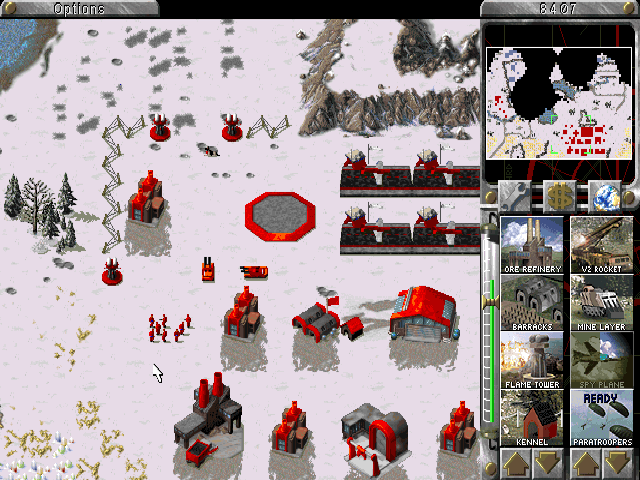
Command & Conquer: Red Alert is a real-time strategy game and the second major title in the series. A prequel to the original game, Red Alert takes place in an alternate world that was created after Einstein traveled back in time to kill Hitler. His intentions were in the right place, but his actions allowed Stalin to run rampant across the entire Eurasian landmass. The single-player campaign is tied together by delightfully campy FMV clips, and the game lets you play as either the Allies or the Soviets. On that note, I really appreciate how balanced everything was. In most RTS games, the different factions were virtually identical to each other and the matches often devolved into a competition over who could create the most units. In Red Alert, each side had distinct advantages and weaknesses. For instance, Soviet vehicles tended to have more power and durability, while the Allied forces were more agile and could build things more efficiently. These differences make the single-player campaign more interesting, and they have an even bigger impact on the multiplayer matches. One of the best things about Red Alert was it’s intuitive user interface that was both user-friendly and complex. Players could queue commands in advance, select groups with a simple keystroke, and control numerous units at a time. All in all, the gameplay felt more developed and responsive than most RTS games that came before it.
4
DOOM
1993
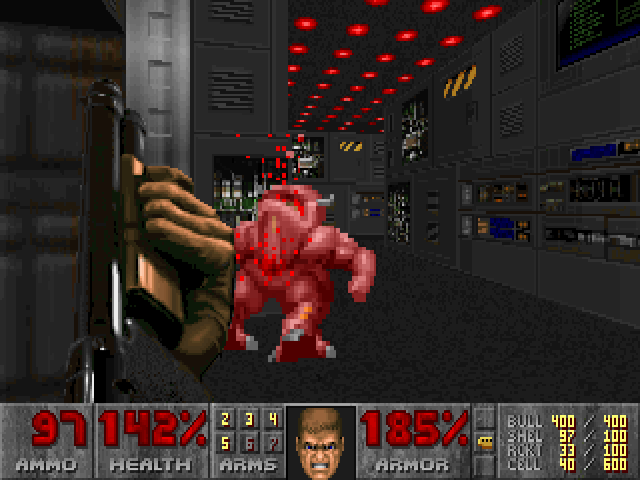
First-person shooters can be found as far back as Maze War in the 1970s, and Wolfenstein 3D helped establish many of the genre’s archetypes in 1992. No first-person shooter was more influential than DOOM, however. In fact, game journalists would routinely use the phrase “DOOM clone” when describing other games in the genre. The game was initially distributed via shareware and mail order, and it helped usher in immersive 3D graphics, networked multiplayer gaming, and support for mods. If you’re somehow unfamiliar with the game, DOOM is a seminal first-person shooter that focuses on an unnamed space marine who battles hordes of demons while traversing military bases. The graphics are simplistic by today’s standards and the combat is relatively straightforward, but the game moves at a break-neck speed and it’s still fun to play. Whether you’re blasting cyberdemons with your shotgun or taking a chainsaw to armies of imps, the game always feels rewarding. When it comes to level design, DOOM is decidedly more complex than many contemporary AAA titles. The maze-like levels are packed with hidden rooms and secret passageways, and the linearity of modern first-person shooters has only served to increase my appreciation of DOOM over time. The thrilling single-player campaign was worth the price of admission on its own, and the deathmatch mode increased the replay value and helped bolster its popularity. It’s not always easy to balance single-player and multiplayer experiences, but DOOM had it figured out in 1993!
3
Quake
1996
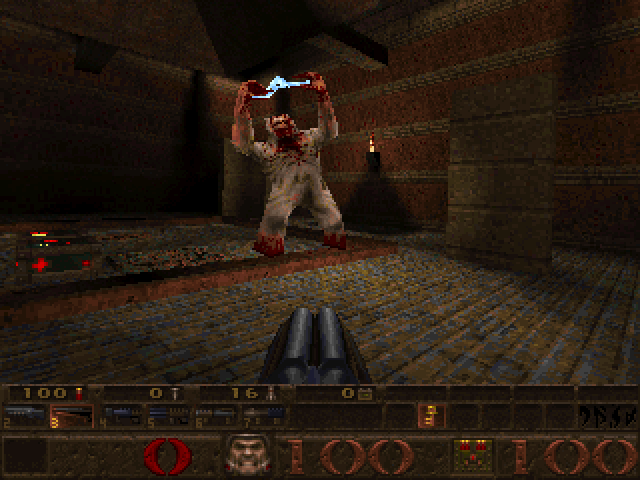
Quake was id Software’s follow-up to the wildly successful DOOM franchise, and expectations could not have been higher. I could wax nostalgic about the gothic art style, the Lovecraft-inspired enemies, and Trent Rezor’s sound design, but I’d rather take the opportunity to discuss how Quake revolutionized the genre. Unlike DOOM, Quake featured full 3D rendering with polygonal enemies and environments. This change was anything but superficial, and movement on the y-axis was more meaningful that it had been in the past. The gameplay in Quake was also more refined than most games in the genre. Advanced strafing mechanics and concepts like rocket jumping gave players more control over their characters and opened the door for all sorts of new strategies. The 28 single-player levels were set in distinctive, maze-like environments, and the game also featured a number of maps that were designed specifically with multiplayer in mind. On that note, Quake helped usher in the age of online gaming, and the QuakeWorld updated allowed for remarkably responsive gameplay even on dial-up. Quake brought first-person shooters to a new level and made it patently clear that the “DOOM clone” moniker was outdated. You might say that the game really shook things up!
2
Worms
1995
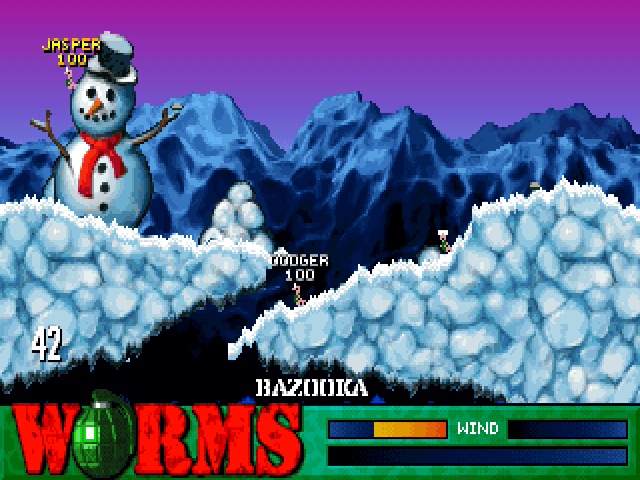
Worms is a turn-based strategy game that shares many traits with traditional side-scrolling platformers. The objective of the game is for players to control a team of worms and eliminate opposing teams. To that end, you’ll have numerous weapons at your disposal. You’ll blast your opponents with bazookas, knock them off cliffs with shot guns, and use sticks of dynamite to take out bridges from underneath them. Players can also choose to take a more defensive approach. For example, you can burrow underground with pick axes, build barricades with steel girders, and reach remote locations by using the trusty ninja rope. The random level layouts and item placements help create a completely unpredictable (and uproarious) gaming environment that lends itself perfectly to multiplayer sessions. The game is fairly mediocre when you’re playing against the computer, but it’s downright hilarious when you get a group of friends together. Ultimately, it’s the unpredictable nature of the game that makes it so compelling. Just when you think a battle is over, you could accidentally step on a land mine and wipe out half of your teammates while rolling into the drink. It wasn’t nearly as influential as any of the other games on this list, but no DOS game made me laugh harder than Worms. Some readers may take issue with how highly the game is ranked, but I have no problem opening up that can of worms.
1
X-COM: UFO Defense
1994
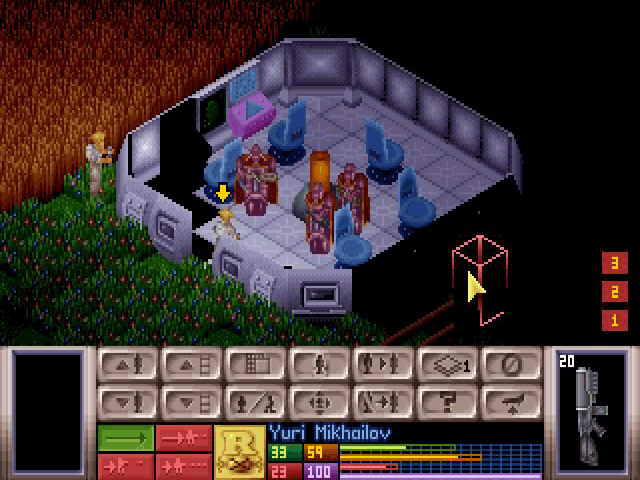
X-COM: UFO Defense (known as UFO: Enemy Unknown outside of America) is a turn-based strategy game with a science fiction theme. There are many things to consider as players lead groups of soldiers against alien forces. There are nine different terrain types in the game (ranging from deserts to jungles), and each one has its own advantages and disadvantages. Moreover, the game’s line-of-sight system ads meaning to every building and object in the game. The set pieces aren’t merely for decoration, and you’ll need to be careful of aliens lurking around every corner. The aliens can also ambush you from the shadows, so you’ll need to be even more cautious at night. The combat is great, but the game also has another side in which players conduct research, develop new technologies, build and expand X-COM bases, manage personnel, monitor alien activity, investigate UFO sightings, and oversee the organization’s finances. The best thing about the game is the lack of a predetermined story. The missions are procedurally generated, and the game doesn’t have any pre-scheduled cutscenes or plot devices. The story unfolds in accordance to the decisions the player makes. As players direct research efforts, they can recover alien technology, interrogate aliens, or even perform autopsies to gain a better understanding than their enemies. Things evolve in an organic fashion, and each playthrough is completely different than the last. Few games have more depth than X-COM: UFO Defense.

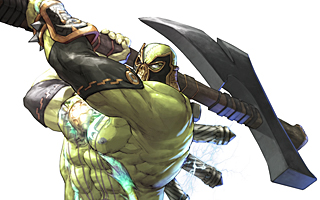
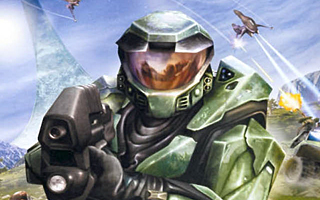

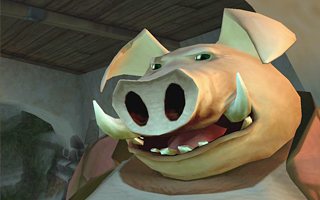
Do you agree with this list? Let us know what you think by leaving a comment below. Your opinion matters!